Pros
Cons
Physical Tour
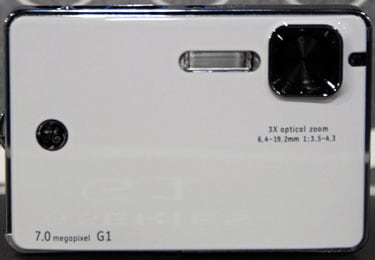
**Back**On the back of the camera is the 2.5-inch LCD screen, which has 153k pixels. Next to this are the mode dial, the buttons for face detection and the on-screen menu, plus the 4-way control (which doubles as a control for focus mode, flash, exposure compensation and the self timer). Finally, a dedicated button consigns the currently displayed image to the trash.
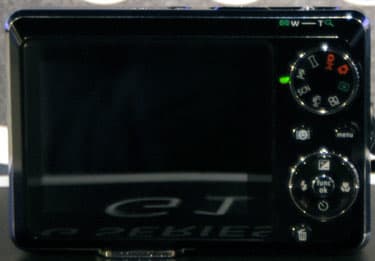
**Left Side**The left side of the camera has no features beyond a couple of screws to hold the thing together.

**Right Side**On the right side is the always exciting lanyard loop. And that’s it.

**Top**The top of the G1 has a number of features: from left to right is the speaker, the small hole for the microphone, the power button, the shutter button and the zoom control.

**Bottom**There are a few notable features on the bottom of the G1. First up on the left is the cover for the battery and memory card compartment, which clicks firmly into place and looks to provide a tight seal against the photographer’s enemies of dust and moisture. Next is the tripod socket, then the small plastic cover for the combined USB and A/V socket. This uses a proprietary socket so don’t lose the cable.
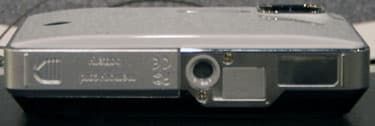
Components
**
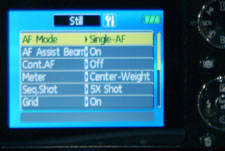
Viewfinder**There is no viewfinder on the G1. All of the framing and previewing of images is done through the LCD screen. **LCD Screen**The LCD screen of the G1 is a 2.5-inch TFT model with 153,000 pixels. That’s a little low for a screen of this size, and images did look rather jaggy. Colors in our limited testing at the PMA show looked acceptable, but they lacked punch. However, this may be due to the harsh lighting at the show; we’ll reserve judgment on the screen until we examine it under daylight and other lighting conditions. **Flash**
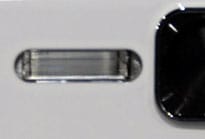
The small flash of the G1 is located right next to the lens, and this could cause red-eye. The G1 does include red-eye removal, but we’d prefer to see the flash located a bit further away from the lens. General Imaging claims that the flash has a range of a foot (at both wide and telephoto), out to 10 feet (at the telephoto setting), or 11 feet (at the wide setting). We weren’t able to test the validity of these claims on the show floor. Check back in the coming months for our full review to see how the G1's flash performs. **Zoom Lens**The zoom lens is a 3x zoom model of unknown manufacturer, with a focal length range of 6.4mm to 13.9mm. The 35mm film camera equivalent is 38mm to 114mm, a pretty standard range that would be adequate for most users. We would like to see more at the wide end, though, since that would make shooting group shots easier. There is no optical image stabilization built into the lens, but the G1 does include electronic image stabilization, where the camera tries to boost the shutter speed to eliminate camera shake.
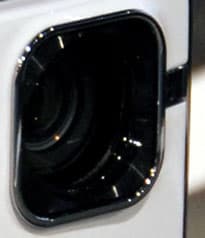
Design/Layout
**Model Design/Appearance**Overall, the G1 is a well-designed camera with a clean, smart design with rounded edges and well integrated controls. Although the case is plastic, it feels pretty robust and should not have any issues standing up to use. Our only major concern is that the plastic could scratch, and that it does seem prone to picking up greasy fingerprints. **Size/Portability**At 0.8 inches thick, 3.6 inches wide and 2.4 inches high, the G1 is a reasonably small, compact camera. However, it is a little thicker and larger than some (such as Casio’s Exilim Card cameras), and is a bit heaver at just over 4 ounces. But it’s not heavyweight and would easily slide into a shirt pocket. It’s just not the smallest camera out there. **Handling Ability**The G1 fits pretty comfortably in the hand, with the fingers falling onto the controls. However, the zoom control is poorly placed on the top of the camera, where you have to use the index finger to control both the zoom and the shutter. This is annoying; when you frame a shot, you have to zoom in or out, them move your finger over to the shutter, a process that involves taking your eye off the screen and could lead to lost shots. The shutter button itself does not require much pressure to trigger. A light touch is all you need to take a shot.

It is possible to use the G1 with one hand if all you are doing is zooming and shooting, but it is not a comfortable experience. It’s much better with two hands. **Control Button/Dial Positioning/ Size**There are a lot of control buttons and dials on the G1, and most are grouped on the back of the camera at the left. This area does feel a little crowded. You can’t really navigate the buttons and dials by touch, and you have to do a certain amount of hunting to find the right one. The control dial on the upper left side of the camera is the most commonly used control, and it is pretty well located for turning with the index finger or the thumb. It’s also interesting that General Imaging decided to give one spot on the dial to the portrait mode. All of the other shooting modes have to be accessed through the on-screen menu that pops up when you set the dial to the Scene mode setting. **Menu**The on-screen menus of the G1 are pretty standard. You access the menu with the menu button and use the directional pad to navigate and select settings.. The menus are structure as follows: A number of controls are also accessed by pressing the Func. button in the center of the 4-way control; Some of these settings (such as white balance and color effect) are not accessible when the camera is in auto mode. **Ease Of Use**Overall, the G1 is a reasonably easy-to-use camera. We aren’t that keen on the placing of the zoom control, but the other control buttons and dials are well-placed for easy use.
Modes
**Auto Mode**When you set the control dial to the auto mode, the camera itself takes control over settings such as white balance and shutter speed. We weren’t able to test how good it was at making decisions at PMA, so we’ll reserve judgment on how good the auto mode is. The user can still set the image size and quality, though. **Movie Mode**The G1 records movies at a resolution of 640 x 480 pixels or 320 x 240 pixels, both at a switchable frame rate of 30 or 15 frames per second. The files are saved as MPEG-4 files, which are pretty small but have high quality. The only limit on the length of movies is the amount of memory available. **Drive/Burst Mode**The G1 has a good selection of burst modes available: you can shoot continuously, shoot a burst of 5 images, shoot continuously and just preserve the last five images, or take images at a preset interval. The latter feature was not working on the preproduction unit that we looked at. General Imaging claims a shooting speed of 2.1 frames per second, with a maximum burst size of 5 images. That’s pretty average. It's enough to try and capture your son catching the football but not enough to capture a complete pass. **Playback Mode**The G1 is a little unusual in offering some basic editing capabilities which is not what we usually see on a point-and-shoot camera. The Playback mode menus has the following options: The editing tools are pretty basic, though. Images can be resized, rotated and trimmed, but there are no color correction or pixel editing tools. In addition, editing an image does not mean deleting the original. The camera will create a new image with the edited version. **Custom Image Presets**13 scene modes are provided on the G1: Sport, Child, Indoor, Flowers, Snow, Beach, Firework, Snow, Museum, Landscape, Night Portrait and Night Landscape. There is also a portrait mode on the mode dial.
Control Options
**Manual Control Options**The G1 does boast a manual mode, which has its own spot on the mode dial. However, this wasn’t fully functional on the preproduction mode that we looked at, so we were unable to ascertain how easy to use this might be. **Focus***Auto Focus*The Auto focus of the G1 was adequate, but not great. In our limited tests at the PMA show in Vegas, it was pretty quick to snap to focus, typically taking under half a second. It did swim a little bit in low light, though. You do get a good degree of control over how the focusing works, with the option to engage the auto focus constantly or just when the shutter is pressed. The G1 can track a single face. To do this, you frame the image with the face in the center, then press the face tracking button. The camera will then track the face in the image, using it as the focus and metering point. In our limited tests, it seemed to work pretty well, keeping track of a face as the subject moved round the frame.* **Manual Focus*No manual focus mode is present on the G1. It’s auto focus only, all the way.** ****ISO**The G1 has a very wide ISO range, starting at 100 and going up to an impressive 3200. The highest setting is only available with a reduced resolution, though. The maximum resolution in this mode is 1.7 megapixels. General Imaging also claims that its considering adding an ISO 64 setting.** ****White Balance**7 options are available for white balance: Auto, Daylight, Cloudy, Tungsten, Fluorescent, Fluorescent H and Measured, which is an evaluative mode. That’s a good selection, and it is nice to see a point-and-shoot camera with a proper evaluative white balance mode.** ****Exposure**As well as the manual mode, there is an exposure compensation control that has a two stop range, in one third of a stop steps.** ****Metering**The usual options for metering are present: a full screen evaluative mode, a center weighted mode, and a spot metering mode.** ****Shutter Speed**The shutter speed of the G1 has a range of 4 seconds down to 1/2000 of a second. In the full manual mode, the longest shutter speed goes up to 30 seconds. Because the manual mode of the G1 wasn’t working on the model we looked at, we weren’t able to judge how easy it is to set the shutter speed manually.** ****Aperture**The aperture range of the small 3x zoom lens is from f3.5 at the wide end to f4.3 at the telephoto end of the zoom range. The maximum aperture setting isn’t known.
Image Parameters
**Picture Quality/ Size Options**Three options are available for image quality: Fine, Medium and Economy. For image size, a large number of choices are offered: 7 megapixels (3072 x 2304 pixels), 6 megapixels at a 3:2 aspect ratio (3072 x 2048 pixels), 5 megapixels at a 16:9 aspect ratio(3072 x 1728), 3 megapixels (2048 x1536), 2 megapixels (1600 x 1200), 1 megapixel (1024 x 768) and 0.3 megpixels (640 x 480). That’s a good selection of choices that provides plenty of flexibility for different sizes of prints. **Picture Effects Mode**The G1 doesn’t include any gimmicky picture effects modes, but it does include a small number of color modes. Images can be captured with vivid, sepia or black and white color modes. These should be used with caution, though since once the image is captured, you can’t undo the color effect.
Connectivity/Extras
**Connectivity***
Software*General Imaging didn’t specify what the software package that would be supplied with the G1 was, but they did say that it would include basic imaging editing capabilities.* **Jacks, plugs, ports*The single port on the base of the G1 does triple-duty as a USB, A/V and power port, which means that you have to use the special cable which is supplied to connect the camera to a PC or a TV for downloading or viewing images. This also means that if you lose or forget the cable, you can’t use a generic one.* **Direct Print Options*Both DPOF (for flagging images for later printing) and Pictbridge (for connecting directly to a printer) are supported, providing a reasonable selection of ways to quickly print out an image without a PC.* **Battery*The lithium ion rechargeable battery in the G1 is rather small, holding only 750 mAh of charge. This is a concern; General Imaging claims a battery life of 200 images, but we would be surprised if the camera achieved this in real life. *Memory*26MB of internal memory is included, and this can be expanded through the use of SD and SDHC cards that can support up to a capacity of 4GB. **Other Features***Panoramas* – A separate panorama mode is present on the mode dial, and this can automatically match and stitch images within the camera. However, this was not working on the preproduction model that we looked at, so we can’t comment on how good or bad it is.
Overall Impressions
**Value**General Imaging hasn’t released the final price of the G1 yet, but it will likely be priced at under $399. We can’t comment on the value for money of the camera without a specific price, but we would expect General Imaging to be aggressive on the price to try and make a dent in a very competitive market. **Who it’s for***Point-and-Shooters* – The G1 is an attractive option for those who just want to shoot and go.
Budget Consumers – It’s hard to say without a precise price point, but we would expect the G1 to be aggressively priced.
Gadget Freaks – There are not enough buttons and shiny features to attract gadget magpies to this camera.
Manual Control Freaks – The G1 does have a full manual mode, and that might make it an interesting choice for the manual control freak who wants a compact camera.
Pros/Serious Hobbyists – Nah. Not enough features, not enough control. And it’ll probably be too cheap for pros, who don’t mind paying the price for serious equipment with durable bodies.
Conclusion
**Conclusion**It’s hard to come to a conclusion on the G1 without knowing the price; General Imaging has said that their new cameras will be priced between $149 and $399 but didn’t specify where the G1 would fall in this range. We would expect it to fall somewhere in the middle, though. This is a value-driven camera that has no outstanding features, so the price and image quality will be what ultimately decides how well it does. But it has most of the features that people look for: decent resolution, a good sized screen (albeit a rather low resolution one) and a decent control system that bodes well for this new camera manufacturer. And it comes with the General Electric logo on the front; a brand that’s synonymous with quality engineering and high technology. We’ll wait to see how well it fits in with this reputation, but price is key in the modern digital camera market.
Specs
**Spec Sheet
**{{manufacturer_specs_table}}{{raw_scores_table}}
Meet the tester
Richard Baguley is a veteran writer who has written about technology ranging from Alphabet to Zip file utilities. He has contributed to pretty much every major tech publication, including Amiga Format Magazine, PC World, Wired, CNET, Toms Guide, Forbes, and many others. He lives in the Boston metro area with his wife, dog, and an indeterminate number of cats.
Checking our work.
Our team is here to help you buy the best stuff and love what you own. Our writers, editors, and experts obsess over the products we cover to make sure you're confident and satisfied. Have a different opinion about something we recommend? Email us and we'll compare notes.
Shoot us an email